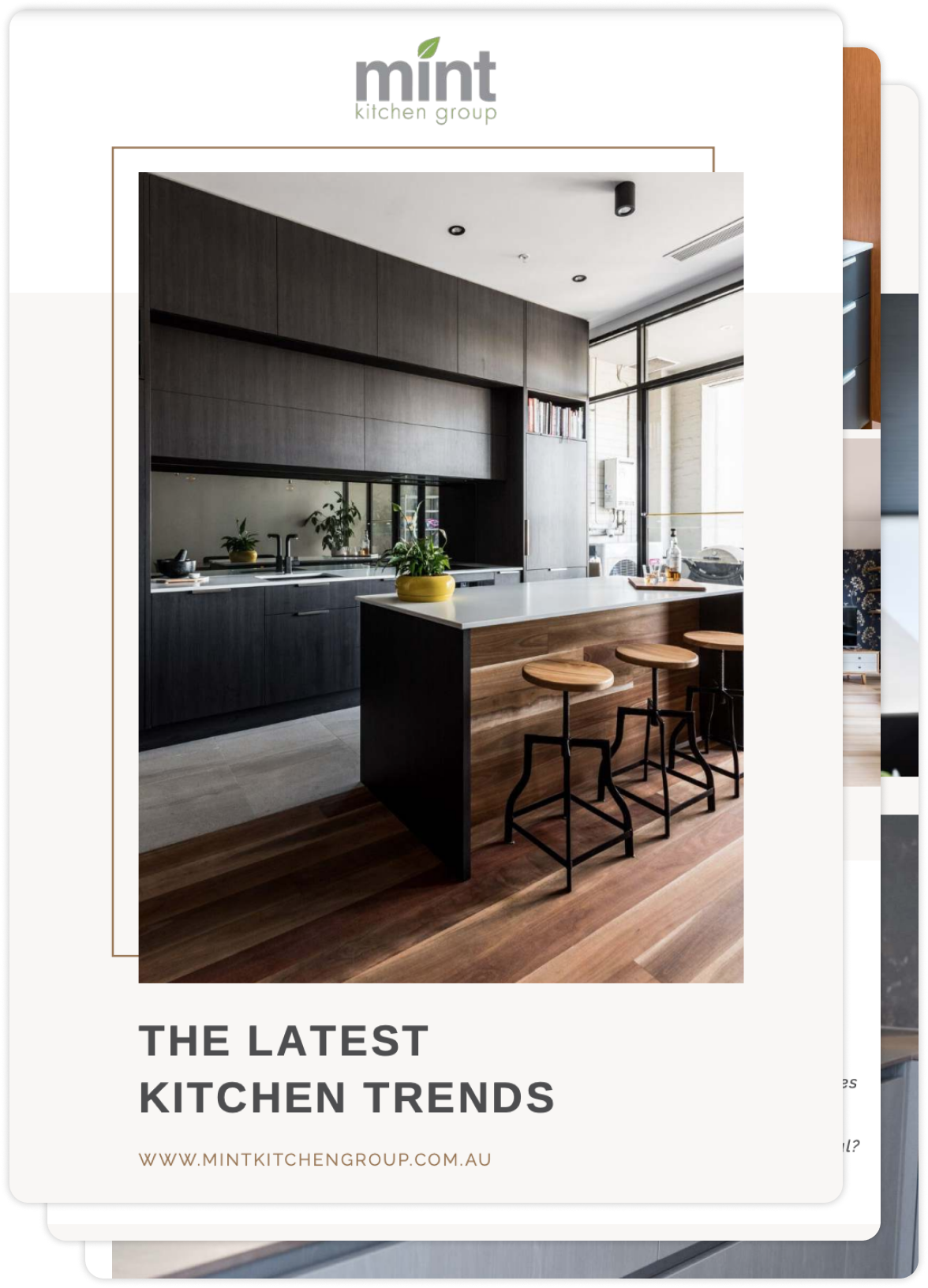Following design trends is an important part of planning your kitchen renovation – knowing what’s in style (and what’s not) can help you hone your ideas and ensure the space created is the ultimate in kitchen design. Our Mint Kitchen Group specialist designers have compiled their Top 5 Trends to Watch in kitchen design to help you with inspiration for your renovation project.
Kitchen Design Trend #1: Curves
The introduction of curves in kitchen design has become a popular trend that offers a unique blend of functionality and visual appeal. Curved kitchen designs prioritise smooth and effortless movement within the space. Curved countertops and islands create a natural flow, allowing for easy navigation and enhancing the overall ergonomics of the kitchen. The ergonomic benefits of curves in kitchen design contribute to a more enjoyable cooking and dining experience.
Curves have the power to soften the overall aesthetic of a kitchen, providing a welcoming and inviting atmosphere. Rounded edges on cabinets, islands, and even appliances create a sense of comfort and harmony. The absence of harsh angles and sharp lines brings a touch of elegance and sophistication to the space.
One of the remarkable advantages of incorporating curves into kitchen design is the ability to maximise space. Curved cabinets and shelving units can effectively utilise corner areas that are often underutilised or difficult to access. These custom-designed curved storage solutions not only optimise functionality but also add a unique and visually appealing element to the kitchen.
Curves in kitchen design can serve as striking focal points and design statements. Curved architectural elements, such as arched doorways or rounded windows, can also complement the overall curved theme, creating a harmonious and visually captivating space.
Curves offer endless design possibilities in kitchen aesthetics. Whether your style is traditional, modern, or eclectic, curved elements can be seamlessly integrated.
Kitchen Design Trend #2: Fluted panels
Finding innovative ways to add visual interest and texture is essential to creating a captivating and inviting space. One trend that has gained significant popularity is the use of fluted panels. Fluted panels, characterised by vertical grooves or ridges, offer a unique and elegant touch to kitchen cabinetry and other interior furniture.
Fluted panels introduce a distinct textural element to kitchen design. The vertical grooves or ridges create depth and dimension, breaking away from the flat surfaces typically found in cabinetry.
Drawing inspiration from the fluting seen in ancient columns and pilasters, these panels bring a touch of grandeur to the kitchen. One of the captivating aspects of fluted panels is the play of light and shadow created by the grooves. Depending on the lighting conditions, the shadows cast by the ridges add depth and dynamic visual effects to the kitchen.
Fluted panels offer a high level of customisation and versatility. They can be incorporated into various elements of kitchen design, such as cabinetry, islands, range hoods, or even as decorative accents on walls. The size and spacing of the grooves can be adjusted to suit different design preferences, ranging from subtle and understated to bold and dramatic.
Kitchen Design Trend #3: Mix-and-Match Materials
When it comes to kitchen design, blending various materials is an exciting and creative way to add visual interest and personality to the space. Mixing and matching different materials in the kitchen allows designers to create a unique and harmonious environment that reflects their client’s personal style.
One of the key benefits of mixing different materials is the ability to create contrast and balance in the kitchen. Combining materials with varying textures, colours, and finishes adds depth and visual intrigue. Incorporating different materials introduces texture and visual interest to the kitchen, plus adds dimension and depth to the space.
Combining matte and glossy surfaces, or blending neutral tones with vibrant accents, adds depth and character to the space. By carefully selecting and coordinating colours and finishes, you can achieve a cohesive and visually pleasing kitchen aesthetic.
Choosing materials that are appropriate for specific kitchen tasks, such as heat-resistant surfaces near cooking areas or easy-to-clean materials for splashbacks, ensures that the design not only looks great but also performs well in day-to-day use.
Kitchen Design Trend #4: Statement Lighting
Lighting plays a crucial role in setting the ambiance, enhancing functionality, and adding a touch of personality to a kitchen. From oversized pendant lights to dazzling chandeliers, statement lighting fixtures are becoming a focal point in kitchens, elevating the space with their captivating designs.
Statement lighting fixtures have the ability to make a bold and unforgettable design statement in the kitchen. With their unique shapes, sizes, and finishes, they become a visual focal point that draws attention and adds personality to the space. Statement lighting allows you to create a specific atmosphere, whether it’s warm and inviting or bright and energetic.
The kitchen is a multifunctional space that requires both task and ambient lighting. Statement lighting fixtures can fulfill both roles effectively. Pendant lights above an island or countertop provide focused task lighting, illuminating specific areas where food preparation or cooking takes place. Statement lighting allows you to showcase your personal style and add a touch of individuality to your kitchen.
Statement lighting fixtures serve as artistic elements that add visual interest and drama to the kitchen and have the power to visually scale the space and enhance its proportions. In large kitchens, oversized pendant lights or grand chandeliers can fill the vertical space and create a sense of balance and grandeur. In smaller kitchens, well-placed statement lighting fixtures can draw the eye upward, making the space appear larger and more spacious.
Kitchen Design Trend #5: Smart Technology
As technology continues to advance, it has found its way into every corner of our lives, including our kitchens. The integration of smart technology in kitchen design has revolutionised the way we interact with and experience this vital space.
One of the most significant advancements in kitchen technology is the introduction of smart appliances. From refrigerators and ovens to dishwashers and coffee makers, these appliances offer enhanced functionality and convenience.
Voice-activated assistants, such as Amazon Alexa or Google Assistant, have become increasingly popular in kitchen design. These intelligent devices can be seamlessly integrated into the kitchen environment, allowing you to control various aspects of your smart kitchen with simple voice commands.
Smart lighting systems have transformed the way we illuminate our kitchens. With smart bulbs and connected lighting systems, you can control the brightness, colour, and ambiance of your kitchen lighting with a smartphone app or voice commands.
Smart faucets have emerged as a convenient and hygienic addition to modern kitchens. Equipped with motion sensors or touchless technology, these faucets allow for hands-free operation, reducing the risk of cross-contamination. Some smart faucets even provide temperature control and volume adjustment through voice commands or smartphone apps, ensuring precise water settings for various culinary needs.
Smart technology enables real-time monitoring and control of energy usage in the kitchen. Smart energy management systems can track and optimise the energy consumption of appliances, lighting, and other devices, helping to reduce waste and lower utility costs.
If you are planning a 2024 renovation and want to take advantage of our Mint Kitchen Group expertise, then drop into one of our four Melbourne Showrooms today!






Leave a Reply